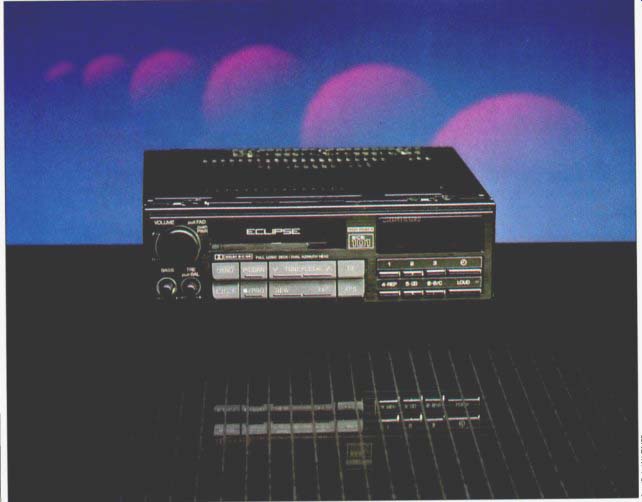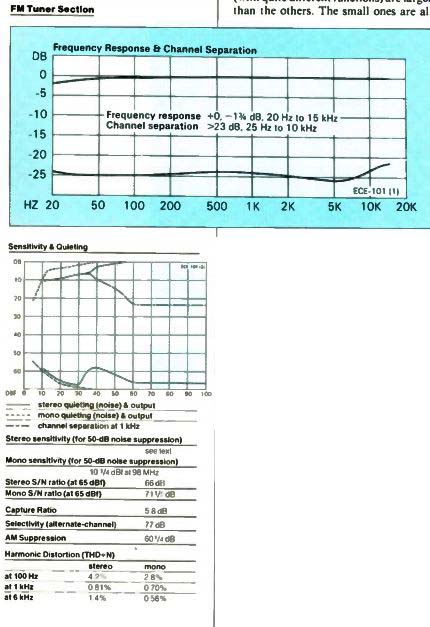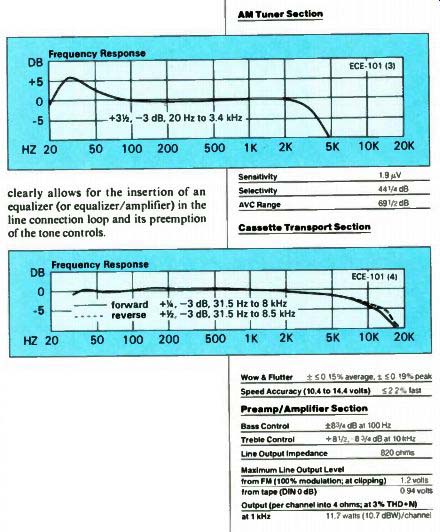
Dimensions:
7 by 2 inches (chassis front), 6 inches deep; trim, 7 1/2 by 2 1/4 inches.
Connections: Plug-in harness with flat male triple-connector for battery, ignition, and power antenna; round male and female for dimmer (panel lights); plug-in harnesses with flat male contacts in four-pin connectors for speakers; special multipin connector for CD player; female pin connectors for line in and line out; chassis stud and spade-lug wire for ground; coaxial female chassis socket for antenna input.
Fuses: 10-amp in ignition line.
Price: $630. Warranty: Limited, three years parts and labor with warranty card (one year if you don't submit it). Manufacturer: Fujitsu Ten, Ltd., Japan.
U.S. Distributor: Eclipse Div., Fujitsu Ten Corporation of America, 19281 Pacific Gateway Dr., Torrance, Calif. 90502.
Eclipse is a new premium car stereo line (though built by old-hand Fujitsu Ten) -- and a welcome one, on the basis of this initial test of a cassette/receiver with more flexibility than most. Certain features of the ECE-101's ergonomics struck me as particularly gratifying during the road tests, and there is a low-key elegance to its front panel that won't disgrace even the most sedate of automotive interiors. There is even an optional dimmer connection, so the readout panel can be fully illuminated during the day (when the dash lights are off) and dim automatically at night to suit ambient light conditions.
Three rotary controls are at the left end of the unit, all with lighting green collars that (together with a similar light in the cassette slot) serve as an on/off pilot. The large knob is the power switch (push), volume (turn), and fader (pull and turn). The other two controls are for tone. The TREBLE doubles as a balance control if you pull it out before rotating it. All three of these functions have clearly detectable center detents. The two knobs will stay virtually flush with the front panel (preventing accidental reset ting when you're adjusting volume) if you push them in; another push will pop them back out. Although the fader is awkward to adjust and the balance/treble combo seems a bit arbitrary, the scheme works because all but the easily used VOLUME and POWER are set-and forget functions.
--------------
Test Reports
FM Tuner Section
Frequency Response
Channel Frequency response
Channel separation HZ 20 50 100 200 500
Sensitivity & Quieting
stereo quieting (noise) output
mono quieting (noise) & output channel separation at 1 kHz
Stereo sensitivity (for 50-d8 noise suppression) text
Mono sensitivity (for 50-dB noise suppression) 10 1/4 dBf at 98 MHz
Stereo S/N ratio (at 65 dBf) 66 dB
Mono S/N ratio (at 65 dBf) 71 1/2db
Capture Ratio 5 8dB
Selectivity (alternate-channel) 77 dB
AM Suppression 60 ) /4 dB
Harmonic Distortion (THD.N) stereo at 100 Hz 42% 1st kHz 0 81% at 6 kHz 14% M 0110 28%
----------
The tuner and tape controls are just to the right, beneath the cassette slot; those for the tuner are located above roughly comparable tape controls. In the upper rank are buttons for tuner band, preset scan, up and down tuning, and seek sensitivity. (The last, marked DX, has no effect in manual or preset tuning.) Below these are eject, "program" change (reverse-or stop, if you're fast-winding a tape), the two directions of fast wind, and APS (Automatic Program Selector, which stops the fast-wind modes automatically at the nearest inter-selection blank). Finally, there is a bank of small switches, of which the two at the right (with quite different functions) are larger than the others. The small ones are for tuner presets and will hold six AM stations (one bank) and 12 on FM (two banks). When you're playing tapes, the bottom three buttons are used, respectively, for repeat of the current tape side, Dolby noise-reduction on/off, and B/C Dolby decoding. Playback equalization is set automatically based on the keyway (or lack of it) in the cassette shell.
----



-------
(As usual, 70-microsecond EQ is identified as "metal" in the rather skimpy manual.) The switches at the far right are used to display (or set) the clock time and to engage the loudness compensation circuit.
All of this adds up to an exceptionally simple, intuitive control scheme: one that's easily mastered and easy to use while your eyes are on the road. Perhaps the function that sums it up is the tuning.
If you tap the up or down side of the rocker bar, frequency steps up or down manually by full channels: 0.2 MHz on FM, 10 kHz on AM. But keep the bar pressed for more than a half-second, and the tuner automatically enters the seek mode and skips over the frequencies that harbor no station above the seek thresh old. I can't recall such a feature in any of our past tests, and I hope it becomes an industry standard in the future.
FM response is very flat, with only a moderate rolloff in the deep bass. Separation is just about 25 dB (moderate, but more than adequate) across the band un der standard test conditions. Greater signal strength doesn't add very much separation; weaker stations encounter a progressively greater blend. The blend also seems to depend on modulation level; on Diversified Science Laboratories' test bench, the reduction in noise and distortion was noticeable when audio level dropped. During the road test, I noticed similar effects occasionally, but they tended to be masked by road and wind noise.
Below 40 dBf, stereo is little more than nominal, though quieting remains better than 50 dB (the sensitivity rating point) to less than 13 dBf, where separation is nil. As usually is the case in car stereo tests, we consequently list no stereo sensitivity point, though the 101's mono sensitivity is outstanding. Eclipse says its proprietary differential-input IF buffer amp is responsible for the excel lent noise performance that makes this possible.
Output attenuation begins at a fairly high input level (output is down about 3 dB at 40 dBf), and the fading action in creases gradually as signal level continues to drop. The resulting attenuation of poor-reception noise bursts and the avoidance of rapid attenuation or collapse of the stereo image make the listening experience notably less disturbing than it often is in the severe-multipath/ fading road test. In fact, both FM and AM (despite a response peak in the latter's very deep bass that you might need to tame, if you have a good subwoofer)
perform exceptionally well on the test bench and on the road.
Eclipse is understandably proud of the dual azimuth adjustment in its auto reverse deck. Separate adjustments seem the only way to ensure good azimuth in both directions of tape play -particularly if you plan to use the deck often and only infrequently trade it in for a new model. So we were dismayed when the lab reported very poor azimuth match to its BASF test tape. And the failing was easily audible in the test car. Whereas good equipment (the Eclipse tuner section, for instance) sounds rather hot on the high end without EQ, the tape section required considerable treble boost to sound acceptable.
--------
QUICK GUIDE TO TAPE TYPES
Our tape classifications, Types I through 4, are based on the International Electrotechnical Commission measurement standards
TYPE 1 (IEC Type I) tapes are ferrics requiring--normal bias and 120-microsecond playback equalization.
TYPE 2 (IEC Type II) tapes are intended for use with 70-microsecond playback EQ and higher recording bias. The first formulations of this sort used chromium dioxide; today they also include chrome-compatible coatings such as the ferri-cobalt and a few metals.
TYPE 3 (IEC Type III) tapes are dual-layered ferri-chromes, implying the 70-microsecond ( -chrome-) playback EQ. Approaches to their biasing and recording EQ vary somewhat from one deck manufacturer to another, when they are accommodated at all. Formulations of this type are no longer being made TYPE 4 (IEC Type IV) tapes are the metal particle, or alloy,- tapes, requiring the highest bias of all and retaining the 70-microsecond EQ of Type 2
----------
Fortunately, the data show that this is not a fault inherent in the ECE-101.
The exceptional match between the two directions of tape travel, despite the deck/test-tape disparity, speaks well for the design. And Eclipse's own data (sub mitted with the test sample) show that the company is partial to Teac test tapes, whose azimuth traditionally has disagreed with that of most others. This isn't necessarily to say that Teac is wrong-azimuth is really too knotty a chicken-and-egg proposition for that- but among the azimuth tapes we've used over the years, Teac's appear to have borne the least similarity to the others. I don't know that the difference in test tapes can, quantitatively, account for all of the lab's findings here, but it certainly must be counted as a probable major contributing factor. And the data strongly suggest that excellent azimuth match to any given test tape, used for adjustment by a competent technician, might be achieved in both directions for the ECE 101.
Transport speed is somewhat fast, but not to a worrisome degree. More important, speed stability is good both on the bench (the flutter figures) and on the road (as resistance to shock-induced anomalies). The automatic EQ switching (another feature I'd like to see become standard) contributes materially to ease of use, and the presence of both Dolby modes is a decided plus. Inserting a cassette turns on the set automatically; eject is automatic if the ignition is switched off while a tape is playing.
Ideally, the tape section's output should be higher, to match that of the tuner, especially since signals through the latter are more likely to be peak-limited. But this is a minor point in the overall scheme of things.
-------------------
Test Reports
AM Tuner Section ECE 101 (3)
Sensitivity Selectivity AVC Range Cassette Transport Section ECE 101 (4)
--------------
Wow & Flutter ± 5 0.15% average; ± 60.19% peak
Speed Accuracy (10.4 to 14.4 volts) 2.2% last
Preamp/Amplifier Section
Bass Control ±8 3/4 dB at 100 Hz
Treble Control + 8 1/2, -8 3/4 dB at 10 kHz
Line Output Impedance 820 ohms
Maximum Line Output Level from FM (100% modulation; at clipping) 1.2 volts from tape (DIN 0 dB) 0.94 volts Output (per channel into 4 ohms; at 3% THD+N) at 1 kHz 117 watts ( 10 7 dBW)/channel.
------------
The tone controls are fairly standard for their type and appear to shelve be yond the reference frequencies cited in the data. The loudness compensation is not at all standard, introducing about 1 dB of deep-bass boost and a gradual high-frequency rolloff (-3 dB at 8 kHz) even with the volume at maximum. Reducing volume progressively increases the bass boost (relative to 1-kHz response) and reverses the treble attenuation. By the time the volume has been backed off by 20 dB, loudness compensation is about + 10 dB below 100 Hz and +4 dB above 10 kHz.
Four switches on the ECE-101's bottom panel can be used to customize a sys tem. One changes the AM channel width to 9 kHz (the standard in some countries). The other three respectively defeat the tone controls, defeat the fader, and switch from the special DIN CD-player input to the line input. The switching A clearly allows for the insertion of an equalizer (or equalizer/amplifier) in the line connection loop and its preemption of the tone controls.
For many users, a more obvious step up would be the addition of separately powered subwoofers in the car's rear deck. The standard setup anticipates this by feeding the back fader-controlled signals to the line-out connections. The built-in amplifier already supplies a little more than 11.5 watts (Eclipse's rating, at 1 kHz and 3 percent distortion in to 4 ohms) in each of its four channels, which should be more than adequate in many installations. But using a separate amp for the subwoofers avoids loading down the rest of the range with the demands of the deep bass.
Obviously, there is a great deal to ad mire in the ECE-101, and I'm not even convinced that its least attractive aspect (the tape azimuth problem) necessarily represents more than a misadjustment of my test sample. That it is remediable (by a service technician) is more than can be said for the azimuth problems we regularly encounter in many other car decks.
The control approach and the tuner section are unequivocally excellent. The preamp and amplifier design, while it can never be all things to all users, also seems well above par in both capability and adaptability. I expect we'll be hearing a lot more from Eclipse in the future.
-Robert Long
-------------
Also see:
Cambridge Audio CD-2 Compact Disc player (review, Oct. 1988)